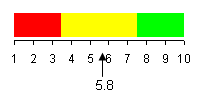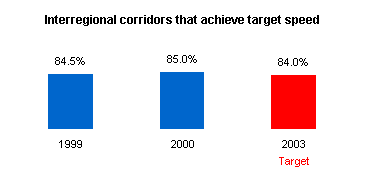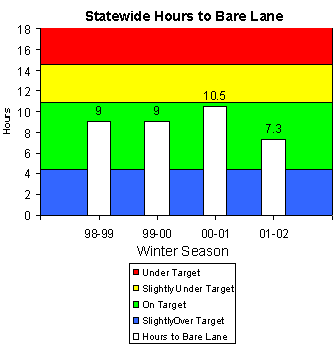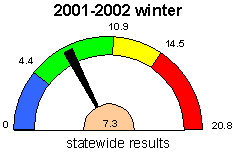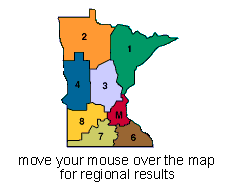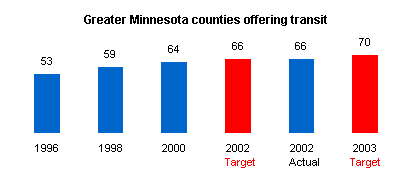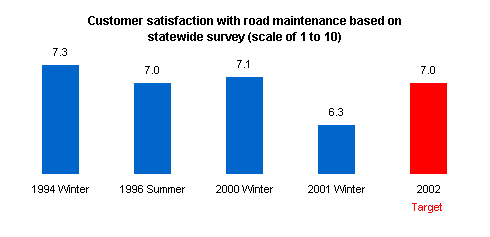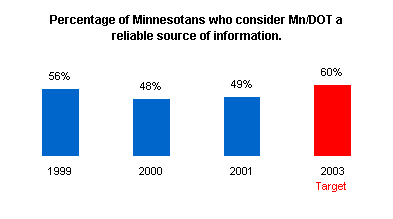
|
Multimodal Transportation In 1976, the Minnesota Department of Highways changed its name to the Minnesota Department of Transportation, reflecting the state's need for long-term, comprehensive transportation solutions. To realize that change, Minnesota must address the economic need to move goods and agricultural products around the state, and the growing social costs and burdens of congestion, for citizens and communities. In the new economy, which includes "just-in-time inventories" and Internet shopping, Minnesota's future economic competitiveness is dependent on how successful we are at moving people and products around with the least hassle possible.
|
|||||||||||||
The Big Accounting Initiative
Score High-priority interregional corridors that achieve target speed of 60 mph. Average hours to achieve "bare lanes" after snowfall - composite of all state highways. The Hiawatha Light Rail Transit line: on time and on budget. Greater Minnesota countywide transit. Construction projects let in the year planned. Customer satisfaction statewide survey results on a scale of 0 to 10. Percentage of Minnesotans who consider Mn/DOT a reliable source of information. |
|||||||||||||

|
|||||||||||||
High-priority interregional corridors that achieve target speed of 60 mph. |
|||||||||||||
|
|
|||||||||||||
Why is this indicator important? In 1999, to help prioritize highway construction investments, Mn/DOT identified the state's major regional trade centers and the key transportation corridors linking them. Long-range planning targets were set to achieve an average travel speed of 60 mph on all high-priority interregional corridors and 55 mph on all medium-priority corridors. These corridors connect Regional Trade Centers (RTC’s) throughout the State and are vital economic and social links. What is
the State
doing?
The 2000 Legislature
provided special funding for a Moving Minnesota initiative to bring
non-performing and threatened segments up to the target speeds. The
short-range targets are to bring an additional 27 miles of high-priority
corridors up to target speed by the end of 2003, as well as 60 miles of
substandard medium-priority corridors. To accomplish this goal, Mn/DOT
is developing coordinated plans with local communities to build new
interchanges, bypasses and safety enhancements, in order to establish
access points which will improve speeds along those corridors. |
|||||||||||||
Learn more about Moving Minnesota at: http://www.dot.state.mn.us/movingminnesota/ Learn more about the Interregional Corridor Study at: http://www.oim.dot.state.mn.us/projects/irc/index.html |
top
|
||||||||||||
Average hours to achieve "bare lanes" after snowfall - composite of all state highways. |
|||||||||||||
|
|
|
||||||||||||
|
|||||||||||||
|
Why is
this indicator important?
This
performance measure is used by Mn/DOT maintenance engineers to
efficiently assign snow plow and sanding trucks and drivers to achieve
timely results for the driving public. Snowplow drivers and supervisors
use the data to monitor their own results against performance targets.
Removing snow and ice from our roads is important to the overall
satisfaction of citizens with transportation services.
What is the State doing? Mn/DOT has an extensive weather tracking system, which is used to alert managers about road conditions. Managers assign resources across the system to clear roads of snow and ice on a priority basis according to the volume of traffic for each road segment. Private contractors are also used where it is more efficient to do so. Is the State meeting the target? Mn/DOT has achieved its overall statewide target for timely snow and ice removal for four straight years under varying weather patterns. Performance for the winter of 2001-02 was well within the target and was the best in the four years that statewide data has been compiled. Overall targets were met for the year by every district and Metro, though not for every month or for every road class in each district. In 2001-02, the statewide target was not met for Super Commuter roads, those with highest volume. |
|||||||||||||
| top
|
|||||||||||||
The Hiawatha Light Rail Transit line: on time and on budget. |
|||||||||||||
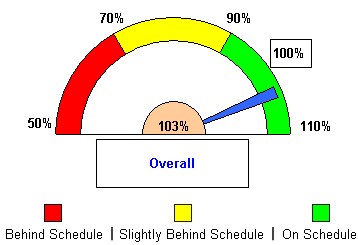 |
More LRT information: |
||||||||||||
Why is this indicator important? The Hiawatha Light Rail Transit project supports Minnesota's commitment to multimodal transportation. What is
the State
doing?
Mn/DOT has set milestone target dates for achieving the first LRT test
run, limited service startup and full service startup. Achieving full
LRT operation by 2004 is dependent not only on the contractor but also
on other Mn/DOT partners, including utility companies, the Metropolitan
Council, the Metropolitan Airports Commission, and city governments. |
|||||||||||||
| top
|
|||||||||||||
|
|
|||||||||||||
Why is this indicator important? This measure helps us understand whether citizens in greater Minnesota (especially transit-dependent citizens) have access to transportation options. This measure helps us understand if we are making progress toward providing customers with transportation options and modal access choices in greater Minnesota. What is the State doing? Mn/DOT has a goal of providing access to transit throughout the state to Minnesotans who lack a reliable source of transportation, especially the elderly, disabled and economically disadvantaged. Mn/DOT provides grants for operating and capital assistance to fund public transit service outside the metropolitan area in 66 of the 80 Greater Minnesota counties. Transit in the seven-county Twin Cities area is administered separately by the Metropolitan Council. Achieving the targets set for 2002-03 is largely dependent on new funding. Is the State meeting the target? Steady progress has been made in closing the transit service gaps in Greater Minnesota. Countywide transit service is currently provided in 66 counties, which meets the 2002 target. Funds appropriated for the biennium were presumed to be sufficient for new public transit in two counties and one city that were poised to implement service. Mn/DOT has managed the appropriation to permit the start-up of a third county system. This meets as much of the 2003 goal as possible given funding availability. |
|||||||||||||
| top
|
|||||||||||||
|
|
|
||||||||||||
Why is this indicator important? This target makes Mn/DOT accountable to its customers - the public - and its partners - construction firms and local government. What is the State doing? Mn/DOT is engaged in several major management initiatives aimed at yielding greater value to the public and its customers for each transportation dollar. These initiatives reduce unnecessary steps in the development of transportation projects and put more accountability and resources in the districts and offices where projects are delivered – closer to customers. Is the State meeting the target? In FY 2001, Mn/DOT let 216 projects for construction, which represents 81% of those projects originally scheduled for that year. Since the construction program is dynamic and subject to a number of internal and external variables (funding, permits, municipal approvals) getting all the scheduled projects let is not a reachable goal hence the target is set at 90% rather than 100%. However, all the dollars available are utilized on these or other worthy projects. |
|||||||||||||
| top
|
|||||||||||||
Customer satisfaction statewide survey results on a scale of 0 to 10. |
|||||||||||||
|
|
|||||||||||||
| Why is
this indicator important?
The indicator is important
because it measures customers’ overall perception of Mn/DOT’s
maintenance performance, over time. Notably, we also track their
perception of specific maintenance services (clearing roads of ice and
snow, visibility of markings on the roadways, road surface smoothness,
etc.). What is the State doing? Since overall customer satisfaction is good and maintenance competes for limited funds with other budget priorities, Mn/DOT has set a target to maintain satisfaction at the current level or better. The department will seek improvement in specific areas highly valued by drivers, such as centerline and sideline reflective striping. Is the State meeting the target? Reasons for the drop are not clear but could be tied to: the overall mild winter in November 2001 to January 2002, and/or the major 30-inch storm that hit western Minnesota just before the survey was conducted (December-January). Additionally, ‘road maintenance’ covers many things in the customers’ minds, everything from road smoothness to snow and ice removal making it difficult to pinpoint the cause of the drop. |
|||||||||||||
| top
|
|||||||||||||
Percentage of Minnesotans who consider Mn/DOT a reliable source of information. |
|||||||||||||
|
|
|||||||||||||
Why is this indicator important? It is important that Mn/DOT’s customers and stakeholders view the agency as a reliable source of information. Public perceptions change slowly. Perceptions are also influenced by information and communications that do not come from Mn/DOT (such as lobbying efforts, etc.) What is the State doing? Mn/DOT will continue to implement strategies outlined in the guidance, “Hear Every Voice: A Guide to Public Involvement at Mn/DOT” (June, 1999). The guidance identifies federal and state regulation for public involvement as well as approaches and best practices for fulfilling these requirements. Is the State meeting the target? The percent satisfied dropped below 50 percent in 2000 and 2001, a period of controversial transportation issues. To close the gap to the 60 percent target by 2005 will be challenging. |
|||||||||||||
| top
|
|||||||||||||
